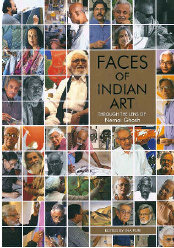 |
 |
 |
 Entertainment | Books | December 2007 Entertainment | Books | December 2007  
Faces of Indian Art: Through the Lens of Nemai Ghosh
 The Hindu The Hindu
go to original


| | Faces of Indian Art: Through the Lens of Nemai Ghosh, edited by Ina Puri, Art Alive Gallery, Rs. 6,500. |
With the value of Indian art soaring in the international market, publishers are cashing in with new titles on the subject. Mapin in particular has launched a series on contemporary painters, starting with Manu Parekh and Krishen Khanna. Faces of Indian Art takes a different line since the aim is documentation rather than criticism. It belongs to a newly emerging genre as the Foreword tells us, showing artists painting or sculpting, each according to his own methods, in his individual, often idiosyncratic work space.

Fifty-two artists have been profiled in an eclectic mix ranging from Tagore and the Bengal School, to the Progressive Artists Group of Bombay, to the Baroda School, to loners working on their own. Apart from getting an insider’s look at their studios we follow their life styles and thought processes in brief essays. Biographical sketches are appended for easy reference.

Nemai Ghosh, long-time associate of Satyajit Ray, initiated this project in 1970 when Ray was shooting a documentary on Benode Behari Mukherjee, a man of such indomitable spirit that he continued to paint even when his eyesight was gone. Having started so early, Ghosh could capture on camera older artists such as Jamini Roy creating his toy-like, minimalist paintings before Minimalism became fashionable.

Valuable insights

Apart from telling us that Jogen Chowdhury places his painting on the floor and kneels beside it, or that Shyamal Dutta Ray uses both his hands, the book provides valuable insights into the minds of the artists. This is particularly so in Geeti Sen’s essay on the creative process which she sees as moving from stimulus to reverie or response, to tentative experiment, culminating in the painting coming to life. The artist’s idiom, she says, flows from his temperament, environment and history, and she divides contemporary art into the iconic, the narrative and the abstract. These are exemplified in the work of M.F. Husain, Nilima Sheikh and Ganesh Haloi respectively. The most poignant image Sen leaves with us is that of Benode Behari feeling his way around his paper collages and cut-outs as Matisse, also sightless, did in his last years.

S.H. Raza is perhaps the most cosmopolitan of the artists in this selection. Living in France but inspired chiefly by India, he is moved “by the latent desire to sustain a dialogue of civilisations”. His art is not narrative or figural. Apart from his signature mandalas he painted only French landscapes in geometric configurations.

We see him in the clutter of his studio, surrounded by reminders of India: wood sculptures, metal figurines, Rajasthani wall hangings and his own creations, particularly the bindu, that elemental source from which energy radiates outwards in bursts of primal colour symbolising earth, air, fire, water, and sky. He has never ceased to be fascinated by it. In his notebook is inscribed a line of poetry: “From the black shunya (void) floats the perception of this world”.

Satish Gujral’s distinctive style derives from his early training in Mexico. Caught up in the horrors of Partition, he depicts its victims in the highly volatile manner of the Mexican Expressionists in a whirlwind of brushstrokes. Weeping, bewildered figures, their bodies writhing, their eyes cast upwards in despair are depicted with a raw energy that leaves an indelible impression on the viewer.

His lines are geometrical in their angularity and sharpness, and there is a rhythm in his art approaching that of music. It is this powerful, pulsating effect that makes his work so compelling.

Vivan Sundaram, we are told, uses clashing techniques and garish colours and yet achieves a balance, since he is “a fine organiser of inconsistent realities”. One fails to see these qualities in the art installation presented here, which consists of a steel rack for office files piled at least 8 feet high with scraps of torn paper. It makes as little sense as did that mother of art installations, Damien Hirst’s dead cow (or was it a dead sheep?) floating in a tub of formaldehyde. Surely there are finer examples of “balance” than this.

The photographs are undoubtedly taken by a master and there are some stunning artworks — a seated figure sculpted by Chintamoni Kar, a Sabavala painting of arcs, planes and criss-cross razor-sharp lines radiating from a central point in bursts of glorious colour. But there are sometimes six pictures of an artist but a disappointing absence of full-page reproductions of paintings. Above all there is no Index, which makes the going tough for serious readers. | 
 | |
 |



